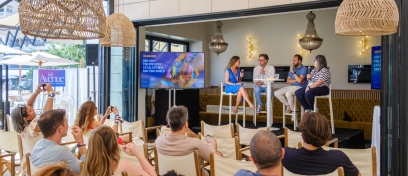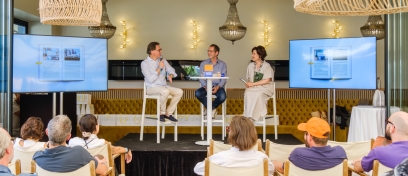For brands
Out-of-home: giving brands a voice
"Hello, I'm OUIbot, your travel assistant. Just a few words are all I need to find your train!"
If you were in the Gare de Lyon or Saint-Lazare train stations in Paris in early 2019, you might have heard this greeting from the OUIbot virtual assistant developed by SNCF, the French national railway company, to provide faster, more personalised and more straightforward customer service.
Devised by JCDecaux's La Rue/Inspiring Outdoor event and experiential advertising department and displayed on JCDecaux digital screens, the friendly chatbot invited passengers to talk to it to find and book their tickets, just as they would with a regular SNCF ticketing agent.
 Customers engage with Ouibot
This innovative campaign saw more than 100,000 people communicate with OUIbot on the first anniversary of OUI.sncf, the company’s European distribution channel. OUIbot is also operational on mobile and desktop and handles around 50,000 monthly customer interactions online.
Customers engage with Ouibot
This innovative campaign saw more than 100,000 people communicate with OUIbot on the first anniversary of OUI.sncf, the company’s European distribution channel. OUIbot is also operational on mobile and desktop and handles around 50,000 monthly customer interactions online.
OUIbot is representative of the growing worldwide use of virtual assistants by rail companies to enhance customer service by reducing the volume of traffic handled by human agents. The UK’s Trainline has built a voice-based service based on Google Assistant to provide passengers with real-time travel information; while the Indian Railway Catering and Tourism Corporation has developed a similar service that works in multiple languages.
 Customers use the voice assistant
These voice interfaces offer several advantages:
Customers use the voice assistant
These voice interfaces offer several advantages:
 Ouibot helps customers with their journey
The rise of voice assistants forms part of the burgeoning global trend for brands to use out-of-home advertising space to connect with consumers by providing a service and positioning themselves as part of the ‘smart city’. Major international companies such as Google, Samsung and Coca-Cola have worked with JCDecaux to provide useful or fun ‘smart’ services as part of out-of-home campaigns in various cities across the world, driving engagement with residents.
Ouibot helps customers with their journey
The rise of voice assistants forms part of the burgeoning global trend for brands to use out-of-home advertising space to connect with consumers by providing a service and positioning themselves as part of the ‘smart city’. Major international companies such as Google, Samsung and Coca-Cola have worked with JCDecaux to provide useful or fun ‘smart’ services as part of out-of-home campaigns in various cities across the world, driving engagement with residents.
Summing up the appeal of OUIbot, Béatrice Tourvieille, Marketing Director of Oui.sncf, commented to Emarketing.fr: “Passengers don’t have to fill in pages of forms or go through lots of results to book a trip, they can just talk in natural language”. Whatever the industry, tone or focus, it’s clear that brands’ use of voice assistants and ‘smart’ services in their out-of-home campaigns to make life easier for consumers is only going to grow.
If you were in the Gare de Lyon or Saint-Lazare train stations in Paris in early 2019, you might have heard this greeting from the OUIbot virtual assistant developed by SNCF, the French national railway company, to provide faster, more personalised and more straightforward customer service.
Devised by JCDecaux's La Rue/Inspiring Outdoor event and experiential advertising department and displayed on JCDecaux digital screens, the friendly chatbot invited passengers to talk to it to find and book their tickets, just as they would with a regular SNCF ticketing agent.

OUIbot is representative of the growing worldwide use of virtual assistants by rail companies to enhance customer service by reducing the volume of traffic handled by human agents. The UK’s Trainline has built a voice-based service based on Google Assistant to provide passengers with real-time travel information; while the Indian Railway Catering and Tourism Corporation has developed a similar service that works in multiple languages.

- Faster service: we can say roughly 200 words per minute – significantly more than the average of 70 that we can type.
- Ease of use: the technology is straightforward and practical: as chatbots understand natural language, there's no need to learn how to use the interface - you simply talk!
- Accessibility: whatever the person's physical condition, mobility, language or age, everyone can use virtual assistants: the interface is intuitive, adapting to the user’s voice and vocabulary and their surrounding environment.
- Personalised interactions: chatbots react to individual users to provide personalised responses tailored to their requests, while maintaining a consistent brand identity.
- Humanising aspect: the interface is designed to create a frictionless experience between the individual and a computer system. For example, OUIbot has the intelligence to discuss a range of subjects with courtesy and even a touch of humour, and instantly displays the information that passengers need to complete their journeys.

Summing up the appeal of OUIbot, Béatrice Tourvieille, Marketing Director of Oui.sncf, commented to Emarketing.fr: “Passengers don’t have to fill in pages of forms or go through lots of results to book a trip, they can just talk in natural language”. Whatever the industry, tone or focus, it’s clear that brands’ use of voice assistants and ‘smart’ services in their out-of-home campaigns to make life easier for consumers is only going to grow.



